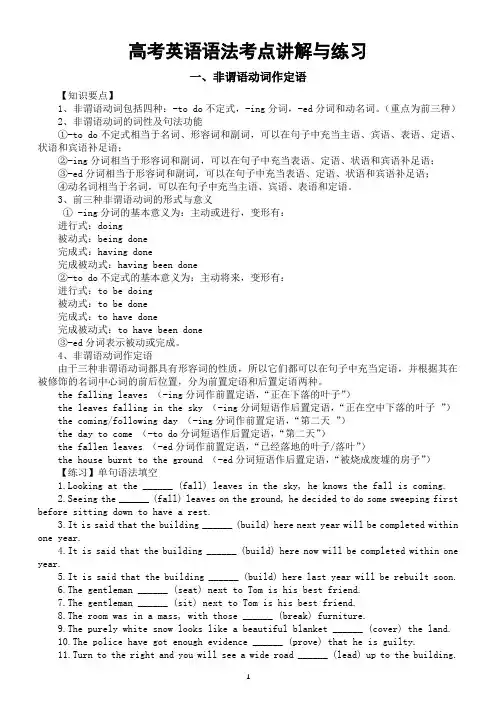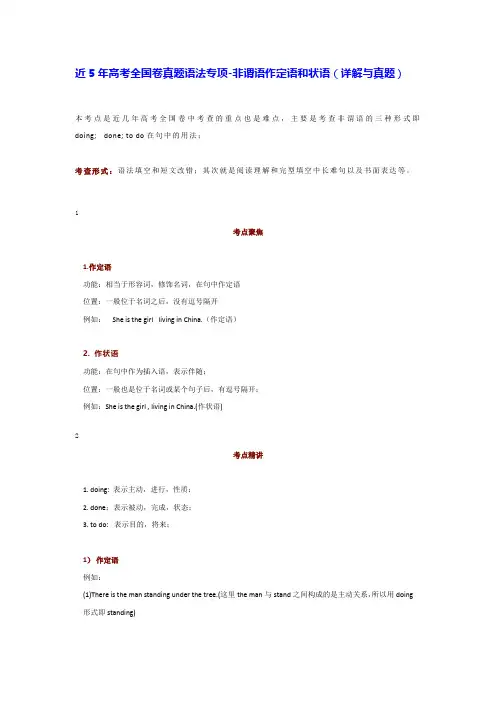上海高考英语语法复习4非谓语作状语
- 格式:ppt
- 大小:177.00 KB
- 文档页数:34



高考英语非谓语动词语法讲解(名师总结基础语法知识点,值得下载)【非谓语动词作状语】一.不定式,分词作状语的基本原则不定式,分词作状语时,不定式,分词的逻辑主语必须与句子的主语保持一致,即不定式,分词作状语时必须和句子的主语保持一致,即不定式,分词作状语时必须和句子主语含有逻辑上的主动或被动关系,否则一般不能使用不定式,分词作状语.二.不定式作状语1.不定式作目的状语不定式作目的状语的情况比较多,如果强调目的性时,不定式前还可加in order或so as,构成"in order to do"或"so as to do"结构."in order to do"结构作目的状语时,可以放在句首也可放在句中;"so as to do"结构只能放在句中.Her mother plans to fly to Beijing at least four times a year(so as/in order)to visit her.Bob took down my telephone number so as/in order not to forge t it.2.不定式作结果状语不定式作结果状语常用在下列句式中:so...as to;such...as to;...enough to;only to(常表示以外的或事与愿违的结果);too...to等.I'm not so stupid(a fool)as to write it down.Jane hurried back only to find that her mother had left.I'm too tired to stay up longer.备注:在only too..to结构中,too...to...并非是"太....而不能..."之意.此时,与too..to..搭配的形容词常见的有pleased,ready,willing,glad,happy等.I'm only too glad to have passed the exam.3.不定式作原因状语形容词作表语时,后面可接不定式作原因状语,用以说明产生这种情绪的原因.用于这类结构中的形容词常见的有:happy,glad,sorry,anxious,proud,disappointed,angry,surprised,ready,delighted,pleased等.You will never know how happy I was to see her yesterday.4.在"主语+系动词+表语(形容词)+to do"结构中,句子的主语与动词不定式有逻辑上的被动关系,且形容词表示主语的特征或性质,这时,需用不定式的主动形式表示被动意义.该结构中常用的形容词有:easy,hard,difficult,important,impossible,interesting,pleasant,nice,comfortable,safe,dangerous等.This question is easy to answer.This book is difficult to understand.三.分词作状语1.分词作状语时其形式的选择形式意义v-ing(doing) 与句子主语为逻辑上的主动关系,与句子谓语动词动作同时发生,或基本上同时发生having+v-ed(having done) 与句子主语为逻辑上的主动关系,先于谓语动词动作发生v-ed(done) 与句子主语为逻辑上的被动关系,表完成being+v-ed(being done) 与句子主语为逻辑上的被动关系,且与谓语动词动作同时发生与句子主语为逻辑上的被动关系,且先于谓语动词动作发生having been+v-ed(havingbeen done)2.分词作状语的句法功能分词作状语时,可以表时间,原因,结果,条件,让步,行为方式,伴随状况等.为了强调,还可与while,when,once,if,unless等连词连用.When offered help,one often says"Thank you"or "It's kind of you".(时间)Separated from other continents for millions of years,Australia has many plants and animals not found in any other country in the world.(原因)Generally speaking,if taken according to the directions,the drug has no side effect.(条件)He glanced at her,nothing that though she was tiny,she seemed very well.(结果)Having been told many times,he still repeated the same mistake.(让步)The teacher came into the lab,followed by some students.(伴随)四.独立成分作状语有些分词或不定式短语作状语,其形式的选择不受上下文的影响,称作独立成分.常见的有:generallyspeaking一般来说;frankly speaking坦白地说;judging from/by...根据....来判断;considering.../taking....into consideration考虑到.....;to tell you the truth说实话;compared to/with与....相比.Judging from his accent,he is from Hong Kong.Considering your health,you'd better have a rest.To tell you the truth,I am a little tired.五.独立主格结构非谓语动词作状语时,它的逻辑主语应和句子主语保持一致.但有时非谓语动词带有自己的逻辑主语,在句子中作状语,我们称之为独立主格结构.独立主格结构的特点:①独立主格结构的逻辑主语与句子的主语不同,它独立存在.②独立主格结构中作逻辑主语的名词或代词与后面的分词或不定式是逻辑上的主动或被动关系.③独立主格结构一般有逗号与句子分开.独立主格结构的构成:①名词/代词+分词②名词/代词+不定式③with/without+名词/代词+分词/不定式The test finished(=When the test was finished),we began our holiday.The president assassinated(=Because the president was assassinated),the whole country was in deep sorrow.Weather permitting(=If weather permits),we are going to visit you tomorrow.I stood before her with my heart beating fast.【练一练】①Anxiously,she took the dress out of the package and tried it on,only (find)it didn't fit.②Clearly and thoughtfully (write),the book inspires confidence in students who wish to seek their ownanswers.③Group activities will be organized after class (help)children develop team spirit.④(spend)the past year as an exchange student in Hong Kong,Linda appears more mature than thoseof her age.⑤The lecture (give),a lively question-and-answer session followed.【非谓语动词作定语】一.不定式作定语1.作定语的不定式如果是不及物动词,或者不定式所修饰的名词或代词是不定式动作的地点,工具等,不定式后面需有相应的介词.The Browns have a comfortable house to live in.He had no place to live.2.用不定式作定语的几种情况:①不定式表将来The car to be bought is for his sister.②用来修饰被序数词,最高级或no,all,any等限定的中心词,且与中心词为逻辑上的主动关系.He was the best man to do the job.She was the first woman to win the gold medal in the Olympic Games.③有些名词的同根词常跟不定式,因而它们也常跟不定式作定语,常见的有:promise,plan,attempt,offer,decision,refusal,failure,ability,chance,warning,anxiety,eagerness,willingness,readiness等.I don't trust his promise to come for a visit.He said he had no plans to go there.He made an attempt to stand up.二.分词作定语1.作定语的及物动词的分词形式为:v-ing,being+过去分词和过去分词.当被修饰的名词与非谓语动词为主动关系时,用v-ing;当被修饰的名词与非谓语动词为被动关系且表正在进行时,用being+过去分词;当被修饰的名词与非谓语动词为被动关系且表完成时,用过去分词.The houses being built are for the teachers.(被动,正在进行)2.作定语的不及物动词的分词形式为:v-ing和过去分词.v-ing表示正在进行;过去分词表示已经完成.boiling water沸腾的水(表示正在进行)boiled water白开水(表完成)falling leaves正在下落的叶子(表正在进行)fallen leaves已经落下的叶子(表完成)developing countries发展中国家(表正在进行)developed countries发达国家(表完成)三.to be done,done和being done作定语的区别to be done表被动,将来;done表被动,完成;being done表被动,正在进行.Have you read the novel written by Dickens? (表被动,完成)Listen!The song being sung is very popular with the students.(表被动,正在进行)The question to be discussed at tomorrow's meeting is very important.(表被动,将来)【练一练】①There are still many problems (solve)before we are ready for a long stay on the Moon.②Prices of daily goods (buy)through a computer can be lower than store prices.③The flowers (smell)sweet in the botanic garden attract the visitors to the beauty of nature.【非谓语动词作宾语,补语,主语,表语】一.非谓语动词(不定式,动名词)作宾语1.下列动词一般用不定式作宾语,请牢记下面的口诀:决心学会想希望,拒绝设法愿假装.主动答应选计划,同意请求帮一帮.decide/determine,learn,want,expect/hope/wish;refuse,manage,care,pretend;offer,promise,choose,plan;agree,ask/beg,help.She pretended not to see me when I passed by.We agreed to meet here but so far she hasn't turned up yet.此外,afford,strive,happen,wait,threaten等也要用不定式作宾语.2.下列动词或词组一般用动名词作宾语,请牢记下面的口诀:考虑建议盼原谅,承认推迟没得想.避免错过继续练,否认完成就欣赏.禁止想象才冒险,不禁介意准逃亡.consider,suggest/advise,look forward to,excuse/pardon;admit,delay/put off,fancy(想象,设想);avoid,miss,keep/keep on,practice;deny,finish,enjoy/appreciate;forbid,imagine,risk;can't help(禁不住),mind,allow/permit,escape.He got well-prepared for the job interview,for he couldn't risk losing the good opportunity.此外,be used/accustomed to,lead to,devote to,go back to,stick to,object to,get down to,pay attention to,can't stand(无法忍受),give up,feel like,insist on,be busy,have difficulty(in),have a good/wonderful/hard time(in),spend time (in)等短语后也要用动名词作宾语.3.下列动词或词组既可以跟动名词作宾语,也可以跟不定式作宾语,但意义上有区别,要特别注意.to do sth.忘记要做某事forgetdoing sth.忘记已经做过某事to do sth.记着要做某事rememberdoing sth.记得曾经做过某事to do sth.努力做某事regretdoing sth.后悔做过某事to do sth.努力做某事trydoing sth.试着做某事to do sth.打算做某事meandoing sth.意味着做某事4.在动词allow,advise,forbid,permit,consider后直接跟动名词作宾语;如果后面有名词或代词作宾语,则用动词不定式作宾语补足语sb.to do sth.allow/permit/forbid/advise/considerdoing sth.Smoking is forbidden here so we don't allow you to smoke.We don't allow smoking in the wall.5.动词need,require,want作"需要",deserve作"应受,应得"解时,其后用动名词的主动形式(doing)或不定式的被动形式(to be done)表被动意义.be worth后用动名词的主动形式(doing)表示被动意义, 而worthy则需用被动形式.此外,need,require,want后可以接名词或代词作宾语,然后接不定式作宾语补足语,表示"需要/要求/想要某人做某事".to be done(需要)need/require/want doingsb.to do sth.(需要/要求/想要)名词deserve doingto be done名词be worth doingto be donebe worthy名词(表钱数或表价格的名词除外)ofbeing doneto be cleanedThe window needs/requires/wantscleaningworth visitingto be visitedThis place is worthya visitofbeing visitedconsideringThese proposals deserveto be considered6.不定式作动词(词组)tell,show,understand,explain,teach,learn,advise,discuss,ask,decide,wonder,find out等的宾语时,前面常带引导词how,what,whether,where,when,who等,但why后加不带to的不定式.备注:此用法中的不定式的逻辑主语需与句子的主语或宾语保持一致,否则用宾语从句.He showed us how to do the work.(=He showed us how we should do the work)I don't know what to do.(=I don't know what I should do.)We must decide whether to stay or go.(=We must decide whether we'll stay or go)Can you tell me why do it?①The film star wears sunglasses.Therefore,he can go shopping without (recognize).②One learns a language by making mistakes and (correct)them.③In some parts of London,missing a bus means (wait)for another hour.二.非谓语动词作补语1.后接不定式作补语的动词及动词词组advise,allow,ask,beg,cause,encourage,expect,forbid,force,get,intend,invite,love,order,persuade,prefer,remind,require,tea ch,tell,want,warn,wish,wait for,call on,depend on等.You are not allowed to smoke here.The doctor warned him not to eat too much meat.注意:think,consider,believe,suppose,feel,find,imagine,prove,appoint,judge等后常用"to be..."作宾补/主补People considered him to be a great leader.They found the answer to be quite satisfactory.Chinese food is considered to be the healthiest in the world.He imagines himself to be an able man.2.非谓语动词作感官动词(词组),使役动词的宾补listen to,feel的宾语补足语有四种形式,以see为例:doing sth.看见....正做....(宾语与宾补为逻辑上的主动关系)do sth.看见...做了....see+宾语+ being done看见....正在做(宾语与宾补为逻辑上的被动关系)done看见....被做I heard her sing an English song just now.(主动,完成)I heard her singing an English song when I passed by her room yesterday.(主动,正在进行)I heard an English song being sung by the little girl when I passed by her room yesterday.(被动,正在进行)I'd like to see the plan carried out.(被动,没有一定的时间性)2.使役动词make,let,have,get后接复合宾语的情况.do让...做....(宾语与宾补为逻辑上的主动关系)①make+宾语+done让...被做(宾语与宾补为逻辑上的被动关系)He made his workers work 12 hours a day.He tried to make himself understood.do让.....做.....(宾语与宾补为逻辑上的主动关系)②let+宾语+be done让....被做(宾语与宾补为逻辑上的被动关系)Don't let your child play with matches.Let the work be done immediately.do sth.让...做某事doing sth.使....持续做某事(宾语与宾补为逻辑上的主动关系) ③have+宾语+done使....被做(宾语与宾补为逻辑上的被动关系)备注: ⑴.have sth. done还表示"使....遭受..."之意Tom had his leg broken while playing football.Mr.Smith had his house broken into while he was away on holiday.⑵have sb. doing常用于否定句中,其中have有"允许,容忍"之意.I won't have you speaking to your dad like that.⑶have还可用于have sth. to do结构,该结构中have作"有"讲,不定式作定语.I have something urgent to inform you.to do sth.使....做doing sth.使...做(宾语与宾补为逻辑上的主动关系)⑷.get+宾语+done使....被做(宾语与宾补为逻辑上的被动关系)He got me to post the letter for him.The captain got the soldiers moving toward the front after a short rest.I'll get my bike repaired tomorrow.3.下列动词(词组)在主动语态中用不带to的不定式作宾语补足语,但在被动语态中要加上to;它们是"吾看三室两厅一感觉"-5看(look at,see,watch,notice,observe);3使(make,let,have);2听(listen to,hear);1感觉(feel) Someone was heard to come up the stairs.(三)动词leave,keep,find,catch及介词with后加非谓语动词作复合宾语的情况:sb./sth. doing sth.让某人/物一直处于某种状态(宾语与宾语补足语之间是逻辑上的主动关系,表示动作正在进行)sth. undone留下某事未做(宾语与宾语补足语之间是逻辑上的被动关系,表示被动和完成,一般以undone,unfinished,unsettled,untouched为多)1.leavesb. To do sth.让某人去做某事(不定式表示将来的动作)sth. To be done.留下某事要做It's wrong to leave the machine running.(主动,正在进行)The guests left most of the dishes untouched,because they didn't taste delicious.(被动,完成)He left,leaving me to do all the rest work.(主动,将来)We hurriedly ended our meeting,leaving many problems to be settled.(被动,将来)sb./sth. doing使某人/物一直做某事2.keepsb./sth. done使某人/物被......(表示被动且完成,或表示状态)Keep the engine running.You should keep me informed of his whereabouts.sb. doing发现某人正在做某事3.find sb/sth. done发现某人/物.....(表完成或状态)sb./sth.(to be)...发现某人/物....We found him(to be)dishonest.Often I found her quietly weeping alone.I found him buried in a novel.4.catch sb. doing sth.撞见某人正在做某事I caught John reading my private letters.sb./sth. doing(表主动且进行,或表特征)sth. being done(表被动且进行)5.with sth. done(表被动且完成,或表状态)sth. to do(表示将来)John received an invitation to dinner,and with his work finished,he gladly accepted it.With a lot of difficult problems to settle,the newly elected president is having a hard time.(四)常用不定式作主语补足语的句型Sb. be said/believed/known/supposed/reported/considered/found/thought+to do/to have done/to be done/to have been done+其他.He is said to have gone abroad.(=It is said that he has gone abroad.)Heat is considered to be a form of energy.You're supposed to pay the bill by Friday.④The managers discussed the plan that they would like to see (carry)out the next year.11。


![高三英语非谓语动词分词做状语的用法[课件]](https://uimg.taocdn.com/61df01cc0722192e4436f6b1.webp)


高中英语语法专题:非谓语动词作状语非谓语动词作状语 解题步骤1、找到非谓语动词的逻辑主语。
2、看非谓语动词和逻辑主语之间的关系。
如果是主动关系,用现在分词;如果是被动关系,用过去分词。
3、如果非谓语动词是分词,需看分词和谓语动词的先后关系。
如果分词的动作发生在谓语动词之前,要使用分词的完成式。
注:如果分词的逻辑主语不是句子的主语,可以使用状语从句或者独立主格结构。
非谓语动词作状语 考点例题考点1、不定式作目的状语【2018∙全国1】You don’t have to run fast or for long__62 _ (see) the benefit.答案:to see。
句意:要见效果,你不必跑的太快或太久。
不定式作目的状语。
考点2、不定式作结果状语【2015∙全国2】When a new day breaks, the walls have given up their heat and are now cold enough __46 __ (cool) the house during the hotday .答案:to cool。
adj. + to do作结果状语考点3、不定式作原因状语【2012∙全国2】⒖ The old man sat in front of the television every evening, happy ___ anything that happened to be on.A.to watchB.watchingC.watchedD.to have watched答案:A。
adj. + to do不定式作原因状语中,adj.通常表示情绪,不定式表示引起情绪变化的原因。
考点4、现在分词作结果状语【2017天津】14. The hospital has recently obtained new medical equipment, _____ more patients to be treated.A. being allowedB. allowingC. having allowedD. allowed答案:B。

高考英语语法考点讲解与练习一、非谓语动词作定语【知识要点】1、非谓语动词包括四种:-to do不定式,-ing分词,-ed分词和动名词。
(重点为前三种)2、非谓语动词的词性及句法功能①-to do不定式相当于名词、形容词和副词,可以在句子中充当主语、宾语、表语、定语、状语和宾语补足语;②-ing分词相当于形容词和副词,可以在句子中充当表语、定语、状语和宾语补足语;③-ed分词相当于形容词和副词,可以在句子中充当表语、定语、状语和宾语补足语;④动名词相当于名词,可以在句子中充当主语、宾语、表语和定语。
3、前三种非谓语动词的形式与意义① -ing分词的基本意义为:主动或进行,变形有:进行式:doing被动式:being done完成式:having done完成被动式:having been done②-to do不定式的基本意义为:主动将来,变形有:进行式:to be doing被动式:to be done完成式:to have done完成被动式:to have been done③-ed分词表示被动或完成。
4、非谓语动词作定语由于三种非谓语动词都具有形容词的性质,所以它们都可以在句子中充当定语,并根据其在被修饰的名词中心词的前后位置,分为前置定语和后置定语两种。
the falling leaves (-ing分词作前置定语,“正在下落的叶子”)the leaves falling in the sky (-ing分词短语作后置定语,“正在空中下落的叶子”)the coming/following day (-ing分词作前置定语,“第二天”)the day to come (-to do分词短语作后置定语,“第二天”)the fallen leaves (-ed分词作前置定语,“已经落地的叶子/落叶”)the house burnt to the ground (-ed分词短语作后置定语,“被烧成废墟的房子”)【练习】单句语法填空1.Looking at the ______ (fall) leaves in the sky, he knows the fall is coming.2.Seeing the ______ (fall) leaves on the ground, he decided to do some sweeping first before sitting down to have a rest.3.It is said that the building ______ (build) here next year will be completed within one year.4.It is said that the building ______ (build) here now will be completed within one year.5.It is said that the building ______ (build) here last year will be rebuilt soon.6.The gentleman ______ (seat) next to Tom is his best friend.7.The gentleman ______ (sit) next to Tom is his best friend.8.The room was in a mass, with those ______ (break) furniture.9.The purely white snow looks like a beautiful blanket ______ (cover) the land.10.The police have got enough evidence ______ (prove) that he is guilty.11.Turn to the right and you will see a wide road ______ (lead) up to the building.12.If you get the first place, you will win an all expenses ______ (pay) journey.13.All the ______ (question) people supported the government’s latest policy.14.You should keep well the books ______ (borrow) from the library.15.Can those people ______ (seat) at the back hear me?二、非谓语动词作状语【知识要点】非谓语动词作状语由于三种非谓语动词都具有副词的性质,所以它们都可以在句子中充当状语。

近5年高考全国卷真题语法专项-非谓语作定语和状语(详解与真题)本考点是近几年高考全国卷中考查的重点也是难点,主要是考查非谓语的三种形式即doing; done; to do在句中的用法;考查形式:语法填空和短文改错;其次就是阅读理解和完型填空中长难句以及书面表达等。
1考点聚焦1.作定语功能:相当于形容词,修饰名词,在句中作定语位置:一般位于名词之后,没有逗号隔开例如:She is the girl living in China.(作定语)2. 作状语功能:在句中作为插入语,表示伴随;位置:一般也是位于名词或某个句子后,有逗号隔开;例如:She is the girl , living in China.(作状语)2考点精讲1. doing: 表示主动,进行,性质;2. done:表示被动,完成,状态;3. to do: 表示目的,将来;1)作定语例如:(1)There is the man standing under the tree.(这里the man与stand之间构成的是主动关系,所以用doing形式即standing)(2) That is the bike repaired by Tom.(这里the bike与repair之间构成是被动关系,所以用done的形式即repaired)(3) There is a party to be held next week.( 这里有next week表示将来,所以用to do 形式)2) 作状语(1)在句中或句尾用逗号隔开的例如:Tom, living in China, invented the bike.(作插入语)There is the man,standing under the tree.That is the bike,repaired by Tom.注意:用done或是doing还是依据句中的某个名词或是整个句子与动词间的关系(2) 在句子的开头,用逗号隔开例如:Knowing that he is a student, we try our best to help him.(这里we与know之间是主动关系,所以是doing形式)Absorbed in painting, John didn’t notice evening approaching.(这里John与absorb之间构成被动关系,所以是done形式)To complete the job in time, the staffs were working on weekends.(这里表示目的关系,用to do形式)(3)with +sth+doing/done/to do的结构,表示伴随(看sth与动词间关系)例如:With the society developing rapidly, +句子。
![[高三英语]高三英语语法复习非谓语动词作状语](https://uimg.taocdn.com/15d513187375a417876f8f1c.webp)
非谓语动词包括---ing分词、过去分词及不定式,他们不受句子主语的人称和数的影响,不能在句子中作谓语;但具有动词的特征(有时态和语态的变化形式),又具有名词、形容词或副词的特性,所以可以在句子中担任其他语法功能,如在句子中做主语、定语、补语或状语等,下面就其作状语的用法进行分类归纳。
非谓语动词作状语的用法可以用下面图表表示:非谓语动词表主动意义 Doing sth., 主语 + 谓语。
作状语 Having done sth., 主语 + 谓语。
表被动意义 Done, 主语 + 谓语。
Having been done, 主语 + 谓语。
表目的、结果 to do sth.现在,再来详细讲解其用法。
一、表主动意义的Doing sth.与Having done sth1. Doing sth. 表示分词的动作与主句的动作同时或几乎同时发生(虽有先后关系,但两个动作非常紧凑),我们可以用“主动、进行”来记住—ing分词作状语的用法。
.eg: We were sitting by the window, talking about what happened yesterday.(sitting 与talking about两个动作同时进行,talking about …作伴随状语)A crowd of children ran out of the classroom, laughing and talking merrily.(同时进行的动作,作方式状语)Hearing the cry for help, they all rushed out.(Hearing与 rushed out两个动作虽有先后关系,但非常紧凑,hearing…作原因状语) doing 有时只表“主动”并无进行之意。
eg: Seeing on the top of the mountain, you’ll find our city beautiful.Being a student, I must study hard.2. Having done sth.表示分词的动作比主句的动作先发生,强调“主动、完成”。